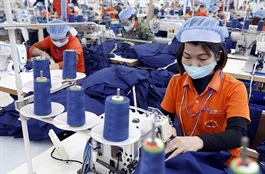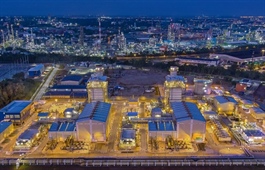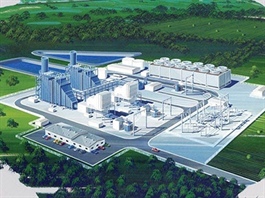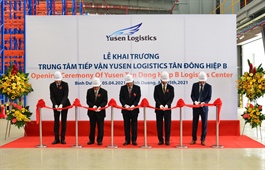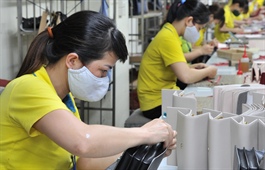GE highlights gas potential in low-carbon energy production
GE highlights gas potential in low-carbon energy production
At an online media roundtable held to share the findings of its latest Whitepaper on energy transition builds, GE has reiterated its commitment to carbon neutrality in its operations by 2030 and to exit the new-build coal power market.

While renewable energy is the future, gas generation offers powerful short-term gains towards sustainability
|
At its online seminar featuring key leaders from its global energy business, GE has highlighted the combination of renewables and gas power to make headways in the fight against climate change and carbon emissions reduction at the shortest time. This is especially true for Asia, where the power density of gas power makes it well-suited to meet forecast skyrocketing demand coming from significant population increase in the next decade and beyond.
While the long-term vision for power generation is definitely zero-carbon featuring renewables, Jeff Goldmeer, Emergent Technologies director, GE highlighted that neither the grid nor storage infrastructure are ready for a full switch to renewables.
“Battery storage technology is not economical to support demand beyond a stretch of up to eight hours and will not be competitive for durations greater than eight hours until there is a significant technology breakthrough,” he explained.
He added that while neither renewables nor gas will be sufficient alone, deployed in tandem they could provide decarbonisation at a sufficient pace and scale to help achieve substantial climate goals.
Meanwhile, Ramesh Singaram, president and CEO of GE Gas Power in Asia and GE ASEAN and ANP as well as Som Shantanu, Regional Engineering director at GE Gas Power both highlighted the multiple technical pathways to achieve lower-carbon generating footprint through the use of low- and zero-carbon fuels in gas power production. They explained carbon can be reduced in all three stages (pre-combustion, combustion, and post-combustion) of power generation, resulting in a potential reduction of up to 60 per cent in CO2 emissions compared to coal generation – measured on GE’s industry-leading HA-class turbines fuelled by a 50-50 mixture (by volume) of hydrogen and methane.
Winning combination
The speakers at the roundtable also highlighted that gas would be vital for Asian countries in moving towards their reduced and net-zero generation goals. Different sub-regions of the continent have varying focuses – a push for replacements and renewables in North Asia, infrastructure growth in ASEAN, and grid firming in Australia and New Zealand – with policy directions already in place to promote the shift to gas and renewables.
GE experts cited the Whitepaper’s findings to show that gas is an optimal generation source to complement renewable capabilities. While wind and solar energy should be prioritised whenever available, during times of prolonged downtime – seasons of muted wind or lowered sun irradiation – there is need for a flexible and dispatchable generation source that can pick up the slack quickly and efficiently whenever necessary.
Andrew Bedford, KBR, director of Advisory and Energy Transition explained at the event that the eight-hour limitation for energy storage technology poses a substantial need for non-renewable generation. This timeline makes gas generation a fitting technology as GE’s HA-class turbines require no more than a 30-minute ramp-up time to reach full generation capacity.
These turbines also come with the lowest capital expenses, providing affordable and dependable capacity. While initial investment can appear costly, GE’s HA-class fleet builds on 80 years of engineering excellence to provide top-of-the-class efficiency. Additionally, the producer’s life-cycle approach extending to operations and maintenance with highly-trained on-the-ground personnel and round-the-clock supervision from its remote monitoring and diagnostics centre in Kuala Lumpur ensures minimal downtime. This translates into more reliability, stability, and overall efficiency over a turbine’s lifecycle.
Another key aspect of carbon-based generation is emissions, with the goal being to reduce and eventually eliminate the tremendous emissions of the energy industry (around 41 per cent of global CO2 emissions). Gas generation offers roughly 45 per cent less emissions compared to coal, which can be increased up to 60 per cent using GE’s HA-class fleet. These turbines are capable of operating on fuel with the highest hydrogen content in the industry (up to half of fuel volume). Experts at the GE roundtable stated these savings are made only in the combustion stage – a further 20 per cent cut can be made by utilising carbon capture and sequestering technologies.
Thus, offering the versatility and reliability to complement renewables, gas is a fitting pairing with its much-reduced environmental footprint, improved efficiency, and lower capital costs.
Vietnam turning to gas
Vietnam is currently in a period of prolonged, fast development with prospects of continued and even accelerated growth. This is contributing to a 10 per cent annual increase in power demand that is already putting pressure on both power producers and the grid.
In its new National Power Development Plan 8 (PDP8), the Vietnamese government has recognised the need for added generation capacity and reducing carbon emissions. Gas is playing a major role in its answer: of the 56GW of new capacity lined up for development, 23GW will come from combined-cycle power plants while another 30GW of gas projects are awaiting approval for inclusion in the plan.
GE sees significant opportunities in aiding this shift, both supporting renewable and gas generation with top-range turbines, as well as carbon-cutting technology. The corporation already works with several LNG-to-power projects in the country, including the 3,600MW Long Son project in Ba Ria-Vung Tau and another LNG power plant in Bac Lieu province.
GE currently provides up to 30 per cent of Vietnam’s generation capacity (40GW) with about 2,000 employees supporting the operations at six locations and 11 power plants across the country. Additionally, GE extends support to global customers from its Phu My repair facility and Dung Quat heat recovery steam generator manufacturing plant.




